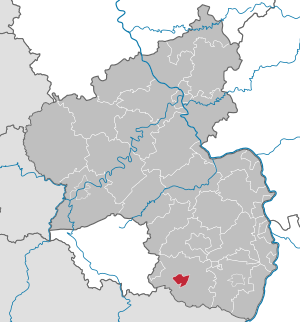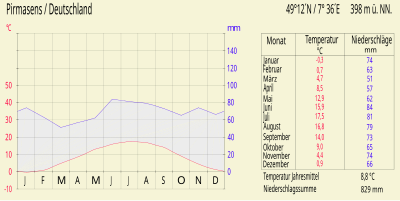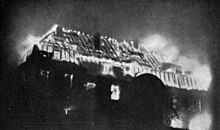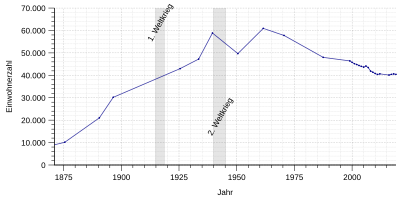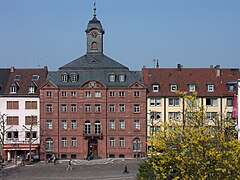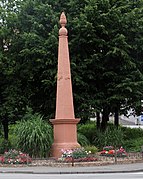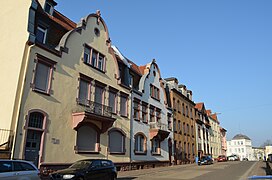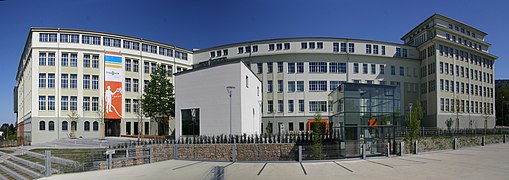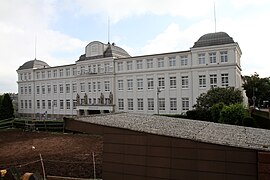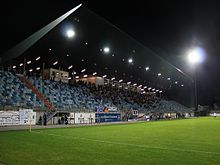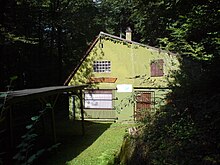Pirmasens
| coat of arms | Germany map | |
|---|---|---|

|
Coordinates: 49 ° 12 ' N , 7 ° 36' E |
|
| Basic data | ||
| State : | Rhineland-Palatinate | |
| Height : | 387 m above sea level NHN | |
| Area : | 61.37 km 2 | |
| Residents: | 40,231 (Dec. 31, 2019) | |
| Population density : | 656 inhabitants per km 2 | |
| Postcodes : | 66953-66955 | |
| Area code : | 06331 | |
| License plate : | PS | |
| Community key : | 07 3 17 000 | |
| NUTS : | DEB37 | |
| City structure: | 8 boroughs | |
City administration address : |
Exerzierplatzstrasse 17 66953 Pirmasens |
|
| Website : | ||
| Lord Mayor : | Markus Zwick ( CDU ) | |
| Location of Pirmasens in Rhineland-Palatinate | ||
Pirmasens - in the local dialect Bärmesens - is an independent city in Rhineland-Palatinate and, in terms of population, the second smallest in the state after Zweibrücken . It lies on the western edge of the Palatinate Forest and is the administrative seat of the district of Südwestpfalz and the Pirmasens-Land association , which surrounds it.
The name goes back to Saint Pirminius , who founded the monastery in the nearby country town of Hornbach . From there, the Pirminiseusna cloister was operated, which became the nucleus of the city (see also Pirminius and the Hornbach Monastery ).
Pirmasens flourished in the 19th century as a German shoe metropolis. In the meantime, however, the economic area is one of the structurally weak regions in Germany.
geography
location
Pirmasens is located on the southwestern edge of the Palatinate Forest in the northwest of the Wasgau , as the southern part of the Palatinate Forest and the adjoining northern part of the Vosges are also called. Immediately to the west is the Zweibrücker hill country . The mean height of the hilly city center is 387 m . In the west lie the independent city of Zweibrücken and the Saarpfalz district , in the north the districts Kusel and Kaiserslautern , in the northeast the district Bad Dürkheim , in the east the district Südliche Weinstrasse and in the south the state border with France with the departments Moselle and Bas-Rhin . Neighboring communities are - clockwise - Rodalben , Münchweiler an der Rodalb , Lemberg , Obersimten , Vinningen , Bottenbach , Nünschweiler , Höheischweiler and Petersberg .
City structure
The core city is divided into eight parts: the historical core is the Horeb, followed by the Kirchberg, the Winzler Viertel, the Schachen and the Husterhöhe. On the periphery, the summer forest - formerly the Maler-Bürkel settlement - is located in the north, the Ruhbank in the southeast and the Erlenteich in the west.
The seven districts - Erlenbrunn , Fehrbach , Gersbach , Hengsberg , Niedersimten , Windsberg , Winzeln - are formerly independent, later incorporated villages; since then the mayor has been replaced by a mayor . The powers of the former municipal council have largely been transferred to the city council , and to a lesser extent also to the new local council .
Surveys
Like Rome , Pirmasens was built on seven hills. In the southeast, the 420 m high Sengelsberg rises on the boundary with Lemberg . The Kleine Arius and the Glasberg extend further north .
Waters
The Felsalb rises on the southern outskirts of the city and a short time later takes in the Erkelsbach from the left , then passes Niedersimten, where it takes in the Gersbach from the left and then the Great and the Little Littersbach from the right ; then it forms the border with Vinningen. The Blümelsbach rises on the western edge of the city center and then winds in an S-shape between Hengsberg and Windsberg and forms the border with Nünschweiler to the northwest of Windsberg. At the northern outskirts of the city, the Steinbach , which runs north, begins, which flows into the Rodalb . The latter partially forms the boundary to Lemberg in the southeast.
climate
The amount of precipitation is high and lies in the upper quarter of the values recorded in Germany. Lower values are registered at 77% of the measuring stations of the German Weather Service . The driest month is April, the greatest amount of precipitation is recorded in December; then there is 1.4 times more precipitation than in April. The amount of precipitation changes little, it is distributed quite evenly over the year. Lower seasonal fluctuations are recorded at only 8% of the measuring stations.
history
To 1900
The oldest surviving documentary mention of Pirmasens comes from around 860 as "pirminiseusna". The name goes back to Saint Pirminius , the founder of the Hornbach monastery to which the settlement belonged. Until 1360/61 Pirmasens remained a parish dependent on the Hornbach Monastery.
Together with Hornbach, Pirmasens originally belonged to the diocese of Metz and came to the diocese of Speyer in 1087 through a donation from Emperor Heinrich IV . Probably at the beginning of the 12th century, the monastery area came under the bailiwick of the County of Saarbrücken and through inheritance in 1182/90 to the new County of Zweibrücken . Soon this county was divided again, so that from the end of the 13th century Pirmasens belonged to the county of Zweibrücken-Bitsch . In 1570 the Counts of Zweibrücken-Bitsch died out with Jakob . This led to an inheritance dispute between the sons-in-law of the last two counts, Philip V of Hanau-Lichtenberg and Philip I of Leiningen-Westerburg . Philip V was initially able to assert himself, but came into conflict with the liege lord of the inherited territories, the Roman Catholic Duke Charles III , due to the immediate introduction of the Reformation . of Lorraine . In 1572 he occupied both parts of the old county of Zweibrücken-Bitsch, the rule Bitsch in the south and the office of Lemberg in the north, to which Pirmasens belonged. It was not until 1606 that the Lorraine troops left the area after 34 years of litigation before the Imperial Court of Justice . In a comparison the area was divided; Bitsch came to Lorraine , the Lemberg office was finally assigned to the County of Hanau-Lichtenberg . Within the office, Pirmasens became the seat of the Pirmasens official school .
The next century brought regular devastation to the region due to the many wars, and epidemics also decimated the population. During the Thirty Years War in 1622 and 1634 imperial troops ravaged the place. From about 235 inhabitants in 1620, the population fell to about 40 in 1657. A temporary recovery was interrupted by a plague epidemic in 1666 and the burning of the village by French troops in 1677. The Palatinate War of Succession (1688–1697) raged again heavily in the area. The neighboring Lemberg Castle was finally destroyed. Since Pirmasens was less destroyed than the completely depopulated Lemberg at the end of the war, the seat of the Lemberg office was moved to Pirmasens in 1697. This made the village the most important place in the area. Another upgrade was the construction of a hunting lodge under Count Johann Reinhard III. Early 18th century. With his death in 1736, the rule of Hanau-Lichtenberg ended and Pirmasens fell to his grandson, the (hereditary) landgrave Ludwig IX. from Hessen-Darmstadt .
Landgrave Ludwig IX. felt so comfortable in his grandfather's hunting lodge in Pirmasens that he granted the settlement town charter in 1763 and moved his residence here. He built the main garrison of the Hesse-Darmstadt army in Pirmasens . The city got a city wall, a castle, a parade ground and the largest parade hall in Europe after the Russian Saint Petersburg . With the Landgrave's death in 1790, the garrison was disbanded and the town's brief prosperity came to an end. In 1793 Prussia and Brunswick defeated the French Moselle army in the battle of Pirmasens . But this could not prevent the victory of the French overall. Like the entire area on the left bank of the Rhine, Pirmasens fell to France in 1793 . From 1798 to 1814, when the Palatinate was part of the French Republic (until 1804) and then part of the Napoleonic Empire , Pirmasens was the seat of the canton of the same name and of the Mairie of the same name , which also included Fehrbach and Ruppertsweiler . In 1815 the place Austria was added. Then the place changed to the Kingdom of Bavaria . From 1818 to 1862 the city was the seat of the Land Commissioner named after it , which was then converted into a district office.
The removal of the border to the south through the annexation of Alsace-Lorraine in 1871 and the railway connection to Landau and Zweibrücken in 1875 brought a renewed upswing for the city . The population took a similar development as in other industrial cities and rose sharply by the turn of the century from under 10,000 to over 30,000 inhabitants.
Since 1900
The Encyclopædia Britannica from 1911 noted under the heading Pirmasens:
“ City in Germany, in the Bavarian Palatinate; 40 miles west of Speyer, population 34,002 (1905), on the Biebermühle railway line. The only noteworthy buildings are the town hall and the main Protestant church which contains a beautiful monument to Ludwig IX (died 1790), the Landgrave of Hesse Darmstadt. The main industry is the production of boots and shoes, but musical instruments, leather and machines are also made. "
After the First World War , Pirmasens belonged to the French part of the Allied occupation of the Rhineland . On March 1, 1920, Pirmasens resigned from the district office of the same name and was henceforth an immediate city . In 1923 and 1924, Palatine separatists tried to gain a permanent foothold in Pirmasens, but failed on February 12, 1924. The district office, seat of the city government, was stormed by citizens. There were several deaths on both sides. Since 1939 the city has been the administrative seat of the district of Pirmasens - from 1997 district of Südwestpfalz - to which it does not belong. The first Allied bombing raid on August 9, 1944 resulted in numerous deaths among the population. Another bombing followed on March 15, 1945, in which the city center was completely destroyed. On March 22, 1945, American troops finally marched into the city, which meant the end of World War II for the population.
After the Second World War , the city became part of the French occupation zone . The establishment of the state of Rhineland-Palatinate was ordered on August 30, 1946 as the last state in the western occupation zones by decree No. 57 of the French military government under General Marie-Pierre Kœnig . It was initially referred to as the "Rhineland-Palatinate Land" or "Land Rheinpfalz"; the name Rhineland-Palatinate was only established with the constitution of May 18, 1947. On October 20, 1956, the Ruhbank settlement, which had previously belonged to Lemberg, was moved to Pirmasens. The US transmitter "Pirmasens-Husterhöhe" based in Pirmasens transmitted the signals from Apollo 11 to Houston / Texas when it first landed on the moon in 1969 . In the course of the first administrative reform in Rhineland-Palatinate , Erlenbrunn , Fehrbach , Hengsberg , Niedersimten and Winzeln were incorporated into Pirmasens on June 7, 1969 . In return, the Neuhof settlement, which is far from the rest of the city, moved to the nearby town of Rodalben. Gersbach and Windsberg followed on April 22, 1972 . In the same year, the city became the seat of the newly formed Verbandsgemeinde Pirmasens-Land , to which it does not belong. In 1989 the Pirmasens location of the Kaiserslautern University of Applied Sciences was opened. The US troops almost completely cleared their Husterhöhe site in 1997 .
population
religion
The priest and founder of the order Paul Josef Nardini, who was beatified in 2006 , worked here as a Catholic pastor from 1851 to 1862 . He died in Pirmasens, and his burial chapel next to the Pirminius Church is now an official pilgrimage site. The Order of the Poor Franciscan Sisters of the Holy Family , which he founded, had its first motherhouse in Pirmasens from 1855 to 1869 and is still located in the city to this day. Nardini's predecessor as pastor from 1807 to 1842 was Johann Michael Schang from Lorraine , who had a reputation for holiness and is buried behind the Pirminius Church. Since 2004 the mother house of the Hildegardis Sisters of the Catholic Apostolate has also been located in Pirmasens.
On November 9, 1938, the synagogue was destroyed during the “ November pogroms ”. Meanwhile, a memorial plaque in Synagogengasse reminds of the location of the building. The three Jewish cemeteries and the memorial plaques in memory of victims of National Socialism - instead of stumbling blocks - at former homes and places of work are still a reminder of the once important Jewish life in the city .
Denomination statistics
According to the 2011 census , 47.5 percent of the population in 2011 were Protestant, 30.6 percent Roman Catholic and 21.6 percent were non-denominational , belonged to another religious community or did not provide any information. Currently (as of January 31, 2020) of the 41,893 inhabitants, 39.7 percent are Protestant, 27.0 percent Roman Catholic and 33.3 percent are non-denominational or belong to another religious community.
Population development
|
|
|
|
The decline in the number of inhabitants since 1970 can be attributed to various causes. The withdrawal of the US armed forces implied a loss of jobs and purchasing power. The unfavorable age structure, the lack of jobs and an unfavorable infrastructural connection also contributed to this. Since 2011, the population has stabilized at around 40,000 for the time being.
Since the start of the refugee crisis in Europe and Germany in 2015, Pirmasens (as of early 2018) has taken in over 1,300 refugees. The Rhineland-Palatinate Ministry of Integration has sent a decree to the local immigration authorities on 20 March 2018 that as of March 26, 2018 refugees without a job in Pirmasens not allowed to move to more Pirmasens. Pirmasens accepted 135% more refugees than would have been required; the cheap rents in Pirmasens are seen as a pull factor .
politics
City council
The city council of Pirmasens consists of 44 honorary council members, who were last elected in the local elections on May 26, 2019 , as well as the full-time mayor as chairman.
Because of the special features of the Rhineland-Palatinate electoral system in local elections (personalized proportional representation), the percentages given are shown as weighted results that only represent the voting behavior in arithmetic.
The parties and voter groups achieved the following results:
| Parties and groups of voters | % 2019 |
Seats 2019 |
% 2014 |
Seats 2014 |
|---|---|---|---|---|
| CDU | 36.3 | 16 | 40.9 | 18th |
| SPD | 24.7 | 11 | 28.0 | 12 |
| AfD | 12.5 | 6th | - | - |
| FWB | 7.2 | 3 | 10.4 | 5 |
| GREEN | 6.5 | 3 | 4.6 | 2 |
| FDP | 4.6 | 2 | 4.1 | 2 |
| THE LEFT. | 3.9 | 2 | 5.6 | 2 |
| The party | 3.2 | 1 | - | - |
| Others | 1.0 | - | 6.5 | 3 |
| total | 100.0 | 44 | 100.0 | 44 |
| Voter turnout in% | 47.5 | 44.3 | ||
- FWB = Free Voters Block Pirmasens
mayor
Louis IX appointed the first mayor (then called Stadtschultheiß ) in 1769, six years after the community was elevated to town status . In 1905 there was the first full-time mayor; Pirmasens has had a mayor since 1920.
|
|
currently in office:
| Surname | Political party | function | in office since |
|---|---|---|---|
| Markus Zwick | CDU | Lord Mayor | 2019 |
| Michael Maas | CDU | mayor | 2019 |
| Denis Clauer | CDU | full-time alderman | 2019 |
coat of arms
| Blazon : "In silver a red tower flanked by two red tin towers with a blue dome, on it a sword-swinging golden lion, standing above two golden lightning bolts radiating on both sides." | |
Twin cities
On September 25, 1965, a town twinning was signed with the city of Poissy ( France ) . This also resulted in partnerships between parishes and associations, for example between the DRK and Croix-Rouge francaise .
Urban finance
The decline of the city's footwear industry as the city's main industry from the 1970s to the early 2000s and the withdrawal of the American garrison in the 1990s had a major negative impact on the city's financial condition. As of December 31, 2012, their debt level was EUR 394.7 million. Measured in terms of per capita debt, it was the fifth most indebted urban district in Germany. As of 2016, the city of Pirmasens had the highest per capita debt in Germany with 8,405 euros cash advances per inhabitant and overtook the previous leader Oberhausen . The aim was to improve the situation by participating in the Rhineland-Palatinate municipal debt relief fund (KEF-RP) from 2012 over a period of 15 years. Despite the lack of a breakthrough in the fight against the increasing debt, the city was responsible for exemplary measures for long-term budget consolidation and the promotion of its future viability such as the energetic optimization of wastewater treatment, the introduction of recurring contributions to road expansion or the establishment of the Pact for Pirmasens 2013 as Germany most sustainable city of medium size awarded. (Winner of the German Sustainability Award ).
Culture and sights
Museums
The Dynamikum on the site of the former Rheinberger shoe factory , the first science center in Rhineland-Palatinate, is known nationwide. The old town hall is the seat of a local history and shoe museum as well as a paper cutting cabinet with works by Elisabeth Emmler. A Hugo Ball collection is housed in the city library . The Westwall Museum is located in the Niedersimten district .
The most important place for cultural events in the city is the festival hall. In addition, the Forum Alte Post has existed as a culture and event center with changing exhibitions since the end of 2013 ; two permanent exhibitions present the city's two most famous artists, the Hugo-Ball-Kabinett pays tribute to the co-founder of Dadaism with an interactive exhibition, while the large urban collection of the genre and landscape painter of the Biedermeier period , Heinrich Bürkel , is exhibited in the country part .
Buildings
Royal Bavarian Post Office
Probably the most representative building in the city is the extensively restored former Royal Bavarian Post Office near the train station. It was built by Ludwig von Stempel from 1891 to 1893 . It is considered an outstanding example in this region of a magnificent administrative building from the early days . Until the reopening in 2013/2014 as Forum Alte Post , it was empty for decades; the visible side of the building with the elaborately designed facade was largely covered by the Hotel Matheis from around 1910 to 2014 . After the hotel was demolished in 2015, Joseph-Krekeler-Platz was laid out in front of the post office building .
Landgrave period
Most of the buildings from the Landgrave era were overbuilt over time or destroyed in the Second World War. Some historically particularly important and cityscape-defining buildings were rebuilt in the post-war period, such as the Old Town Hall on the lower Schlossplatz, the Johanneskirche on the Parade Square and the Luther Church on Hauptstraße. Both churches date from the 1750s, making them probably the oldest buildings in the city today. The Luther Church was originally the court and garrison church in which Landgrave Ludwig IX. was finally buried. Right next to the church is the cobbler fountain and the former garrison school, today the location of the Protestant parish office. In the Kaffeegasse there is still a renovated old grenadier house, one of the many buildings that Ludwig had built for his soldiers in the past. Outside the city limits at that time there are still two large sandstone obelisks that once served as signposts in front of the city gates, which are crowned by the emblem of Louis IX, a flaming grenade: one in the north on Zweibrücker, the other in the south on Lemberger Straße.
The palace square was the former location of the landgrave's palace, it was located on a hillside directly opposite the old town hall, which was the seat of the city government from around 1770 until it was destroyed in 1945. The parade ground, which originally stretched from the southern to the northern ring road, was also built under the landgrave. Later the square was partially built on and reduced to its present size.
Founding period
Due to the relatively late founding of the city and the fallowing of urban development after the end of the Landgrave era, a large part of the city was only built during the economic heyday from 1870 to 1914, so that the cityscape consisted almost exclusively of buildings from the Wilhelminian era until its extensive destruction . Despite the bombing in the Second World War and some waves of demolition in the post-war period, numerous buildings from this period have survived, only a few of them in the center, but mainly in the Wilhelminian-era belt around the Landgrave's oval and the suburbs that extend beyond this, such as the Bahnhofsviertel and the Landauer Tor.
In the city center there are a few old buildings from the Wilhelminian era, above all the late classicistic New Town Hall on the parade ground, which was built as a schoolhouse in 1879. On the edge of the square is the building of the former Bavarian State Bank from the early 20th century. The parish church of St. Pirmin (1897–1900, architect Wilhelm Schulte I. ) On the upper Schlossplatz, with its distinctive double tower facade, can be seen from almost anywhere in the city. It was rebuilt in a simplified manner after it was destroyed in the war; the portal and the two towers have essentially survived from the original building, but their pointed roofs were not restored to their original height after the war. In large numbers, Wilhelminian-style buildings can only be found in Allee- & Bahnhofstrasse. The Zionskirche (1898), which was rebuilt in a simplified manner after the Second World War, and the associated rectory, which survived the war undamaged, are located on Alleestraße. The historically significant former district office is located in Bahnhofstrasse , which forms an ensemble with the late classical labor court building (around 1880) and the old district court building .
Particularly magnificent buildings from the Wilhelminian era emerged in the Bahnhofsviertel, which, unlike the center, largely survived the war. The above-mentioned Alte Post from 1893 with its magnificent neo-renaissance facade is one of the most beautiful secular buildings in Pirmasens. The so-called Post Triangle between Bahnhofstrasse, Schützenstrasse and Gärtnerstrasse is an example of particularly impressive residential buildings from this period; in the immediate vicinity there is another monument zone with attractive villas in the quiet Turnstrasse.
The second large, preserved Wilhelminian-style district is the Landauer Tor . From a name for the former southern city gate, which was actually called Buchsweiler Tor , a location name for the entire area developed at the end of the 19th century. The district begins immediately outside the landgrave's city limits at the level of Bergstrasse and extends mainly around Landauer and Lemberger Strasse, which were developed as representative arterial roads in the early days of the company. The quarter is dominated by late historic architecture alongside individual Art Nouveau buildings . In the Landauer Straße z. B. the Walhalla cinema , which opened in 1913 and still uses the same building today. This makes it one of the oldest continuously existing cinemas in Germany. The western end of the quarter is marked by Bitscher and south of Charlottenstrasse by Simter Strasse, to the east it extends to the old hospital building (1914) in Pettenkoferstrasse, which is now used as a retirement home. Even further to the east on the edge of the Eisweiher Park is the so-called Waldschlöss'l , which has a long tradition as a restaurant and today houses the first star restaurant in Pirmasens, the Brasserie . The southern end of the Wilhelminian style suburb is a small residential area around Villa Loeser , which was preserved from demolition and renovated after a long period of decay.
The imposing school buildings that have been preserved from the imperial era are also worth seeing, including the Matzenberg School (1886/87) on Winzler Strasse, the Horeb School (1904/05) on Herzogstrasse, the former secondary school for girls (1906) on Alleestrasse and the Wittelsbach School (1910) on Maler-Bürkel-Strasse. They were created in quick succession in order to do justice to the rapid population growth at the time.
Well-preserved Wilhelminian-style streets can also be found in the northern Winzler district between Goethe and Fröhnstrasse, on the Husterhöhe with Zweibrücker Strasse leading north out of town, on Horeb with Luisenstrasse and around Kaiserplatz in the south of the city.
Shoe factories
The surviving former shoe factories, which can be found almost throughout the city, are particularly characteristic of the cityscape. They often come from the Wilhelminian era, but their architecture often already takes up features of reform architecture and early modernism, such as the Rheinberger complex above the Streck valley, the western half of which was built in 1905/06 in classic reform architecture, while the administrative building in front of it to the east shows strong influences of modernity in the 1920s. The core of the former Neuffer shoe factory on the Horeb dates back to 1894, was later expanded and, from 1926, was equipped with a magnificent, castle-like facade based on plans by Josef Uhl .
Rheinberger and Neuffer are probably the most prominent examples of completed conversions of previously vacant factory sites. Both were completely renovated and are now used as service centers, the Rheinberger also houses the aforementioned Dynamikum. Further examples of successful conversions are two former Salamander factories on Husterhöhe; While residential lofts were being built in the building in Schwanenstrasse, the JugendKulturWerkstatt , a youth art school of the state of Rhineland-Palatinate under the direction of the International Federation , moved into Glockenstrasse above . In contrast, the listed factory complexes Kopp (1907–1911) on the edge of the city center and Ohr (around 1925) in Hügelstrasse have not yet been fundamentally renovated.
South facade of the Rheinberger to the Strecktalpark
Modern
One of the most important new buildings of the interwar period is the church of St. Anton in the Winzler Viertel, which was built in the Romanesque style between 1923 and 1928. Important early modern buildings in Pirmasens include the Villa Kaiser (around 1920) in Buchsweiler Strasse, the tower-like former shoe last factory Behrens (1922 ff.) In Gärtnerstrasse, and the Stadtbad (1926–1934) in Lemberger Strasse, which still exists today or the former main post office (1928–1930) in Schützenstrasse, which was then built as one of the most modern post offices in Germany in the style of the Bavarian Post Building School . After being temporarily vacant, the main post office was again converted into one of the most modern youth hostels in the country between 2017 and 2019. A separate monument zone is formed by three symmetrical twin houses in the style of reform architecture with individual expressionist elements in Strobelallee, which were probably built in 1924 as civil servants' houses. They form the southern entrance to Strobelallee, which was laid out in the 1920s under the name giver Otto Strobel , which today forms a residential area on the eastern edge of the Horeb. The other end of the avenue is the Villa Rheinberger in Baroque Art Nouveau forms from shortly after 1918 at the entrance to Neufferpark.
Characteristic buildings from the time of National Socialism in the city are the Haus des Handwerks in the Ringstrasse or the barracks that were built on the Husterhöhe at the end of the 1930s and continued to be used by the Americans after the war, including the so-called Banana Building , which is now used as a service center .
From the immediate post-war period, among other things, the Nagelschmiedsbergschule with an elaborate mosaic in the arbor-like vestibule and the prominent Fehrbacher water tower located on the outskirts above the B10 are under monument protection. At the end of the last century, the pedestrian zone along the main street and the castle stairs between the lower and upper castle square were redesigned; the latter now forms an impressive overall complex with the bull fountain. In addition, the parade ground was redesigned according to plans by Paolo Portoghesi in the style of postmodernism .
Nature and parks
The east of the city limits in the Palatinate Forest Nature Park , which in turn is part of the Palatinate Forest-Vosges du Nord biosphere reserve . There are three larger parks in Pirmasens near the city center. This includes the old cemetery , which was abandoned after the forest cemetery was completed in the 1920s and later rededicated as a park. It contains grave monuments from the 19th and early 20th centuries and a modern sculpture park. The former consecration hall is now used as a Carolinensaal for cultural events.
The Neuffer Park was laid out by Emil Neuffer next to the shoe factory of the same name and has a large proportion of very old trees. The Strecktalpark is an industrial wasteland that was renatured in the wake of the failed application for the State Garden Show 2000. A spacious park with numerous recreational opportunities was created on the site of a former tannery.
On the outskirts of the city, not far from the Stadtbad and the hospital, there is the Eisweiher recreational area around the artificial lake of the same name, which used to be used by the city's breweries to obtain ice. The Spesbach sports complex is also part of the local recreation area. To the east, the local recreation area merges directly into the Palatinate Forest.
There are a total of 48 natural monuments on site .
Sports
The flagship of the local sport is the soccer club FK Pirmasens , which played a leading role in the Oberliga Südwest and later in the Second Bundesliga for a long time after the war . After relegations to the regional league, the club now plays in the Southwest Regionalliga . The SG 05 Pirmasens also played at times in higher divisions.
The gymnastics club Pirmasens 1863 is the largest sports club in town with over 1000 members. Another large association is the Pirmasens section of the German Alpine Association with 639 members, which was founded in 1897 and operates the Rudolf-Keller-Haus on the Langmühle belonging to Lemberg .
After 2008, the Rhineland-Palatinate Gymnastics Festival took place for the second time in Pirmasens from May 25 to 29, 2016.
education
In Pirmasens there are the three grammar schools Hugo-Ball-Gymnasium (formerly modern language grammar school), Immanuel-Kant-grammar school (formerly old language grammar school, founded in 1836 as Latin school Pirmasens ) and Leibniz grammar school (formerly natural science grammar school). As part of the Pirmasens Vocational School, there is the German Shoe School as well as a technical and a business high school, both of which, however, only offer the upper level. Since the 2014/15 school year there has also been a technical college specializing in technology / metal technology. The city also has eight primary schools (three of which are in the incorporated suburbs), two secondary schools plus (Landgraf-Ludwig-Realschule plus with the locations Alleestr, Horeb and Husterhöh and Realschule plus Kirchberg) and one special school (Matzenberg special school). There is also the Nardini school (elementary and junior high school), which is run by Catholic institutions. The Montessori School Pirmasens was founded in 2009 as a private primary school and has since been housed in the building of the former Rheinberger shoe factory.
In 1989 a branch of the University of Kaiserslautern was founded in Pirmasens. Originally located on Lemberger Strasse, the "Applied Logistics and Polymer Sciences " department with around 700 students is now located on the Husterhöhe .
Regular events
- Landgrave Days, second weekend in April
- Open-air events on the parade ground (changing music events - opera, musical, rock, pop, hip-hop)
- Schlabbeflicker festival, first weekend in August
- Exe festival, second weekend in September
- Festival Euroclassic (Festival of the cities of Pirmasens, Bitche, Zweibrücken, Blieskastel and the community of Zweibrücken-Land)
- May market, end of April
- Grenadier market, in autumn
- November market, last weekend in October or first weekend in November
- Belznickelmarkt, Christmas market in the Advent season
- Photo days every two years
Economy and Infrastructure
In 2016, Pirmasens generated a gross domestic product (GDP) of € 1.591 billion within the city limits . In the same year, GDP per capita was € 35,983 (Rhineland-Palatinate: € 34,118, Germany € 38,180) and was thus below the national average. The GDP per labor force is € 54,391. Around 26,600 people were employed in the city in 2016.
Economic trends
Pirmasens has been the center of the German shoe industry since the 19th century . However, the lack of competitiveness, especially with regard to goods from abroad, made mass production increasingly difficult for companies from around 1970. Most of the local shoe factories were given up, others were able to survive by outsourcing production abroad and specializing in niche segments. Since the situation also deteriorated in the leather trade, mechanical engineering and the chemical industry, around 15,000 jobs were lost. With the withdrawal of the American military, around 10,000 people - soldiers and their relatives - left the city. A further 4,000 jobs were indirectly lost. The unemployment rate in 2002 was 14.9 percent, in April 2013 it was still 13.6 percent. The value fell to 10.4 percent by September 2019, but was still the highest unemployment rate in Rhineland-Palatinate and was well above the national average of 4.2 percent. The average income in 2016 corresponded to 88.3% of the state funds of Rhineland-Palatinate.
By converting the former barracks and vacant factory buildings for business start-ups, compensation is to be created. In this way, new commercial areas have already been created in some cases. An example of this is the Neuffer complex (Neuffer am Park) , which houses doctors, companies and a radio station, as well as the Husterhöhe business park (former Husterhoeh barracks ), in which the number of jobs increased from 120 to around between the years 2000 and 2016 2700 in a total of 102 companies. The former largest shoe factory in Germany Rheinberger was also converted into an industrial park similar to the Neuffer complex in 2007-2008.
Due to the successes in previous conversion projects and the stabilization of local companies, the job situation has improved again in recent years, so that Pirmasens (as of 2017) has the fifth highest job density among the twelve independent cities in Rhineland-Palatinate with around 20,000 jobs per 40,000 inhabitants . In 2015, the value was 1056 persons in employment at the place of work per 1000 inhabitants of working age. The neighboring district, which despite the lowest job density in Rhineland-Palatinate, has a very low unemployment rate of 4 percent (as of September 2017), benefited more than the city itself.
The aim is to make the location more attractive by improving the infrastructure, for example the four-lane expansion of the B 10 between the A 8 and the A 65 in Landau , or the creation of additional commercial areas through an intermunicipal commercial area together with the town of Rodalben on the Grünbühl (in the north of the Husterhöhe) after the planned withdrawal of the American Medical Center.
In the Future Atlas 2016 , the city of Pirmasens was ranked 374 out of 402 rural districts, municipal associations and independent cities in Germany, making it one of the regions with "high future risks".
Pirmasens trade fair location
Due to the city's national and global importance for the shoe industry, Pirmasens was the only international trade fair location in Rhineland-Palatinate until 2003 . From 1949 Ludwig Kieffer expanded it mainly for large trade fairs in the shoe industry and their suppliers, especially for the Pirmasens shoe and leather goods fair, but the fair has survived the structural change and the loss of importance in the industry. The entire facility offers 20,000 m² of covered space in seven halls, 48,000 m² of open space including parking spaces, a congress area with five conference rooms and a boardroom as well as 1,700 parking spaces for cars and 100 buses. In addition to the trade fairs, the area is also used for exhibitions and daily events.
After the Pirmasenser Schuhmusterung (psm) and the plw (international trade fair for leather, shoe components and more) set the tone in the past, regional consumer fairs such as hageha ( consumer fair for craft, trade and commerce , from 1954 to 2014) took over. , The world of health or culinary delights . As of 2004, the exhibition site was modernized for 8.4 million euros as part of the so-called Vision 2007 exhibition . 80% of the renovation was carried out by the state of Rhineland-Palatinate. In a small request to the Rhineland-Palatinate state parliament in 2005, the losses of the exhibition and event company Pirmasens GmbH amounting to 1.4 million euros since 2000 were discussed.
The city of Pirmasens took over the halls in January 2008, while Messe Pirmasens, as a pure event company with a share capital of 457,000 euros, was only responsible for organizing the trade fairs. In the first year of 2008 a deficit of 177,000 euros was generated. As a result, at the end of July 2009, all 14 full-time employees of Messe Pirmasens were dismissed. The organization of the trade fairs was then privatized, from 2010 to April 2012 Mattfeldt & Sänger Marketing und Messe AG took over the support; Das AgenturHaus GmbH has been responsible for this since 2012 , which established additional trade fairs in Pirmasens such as Anja - the trade fair for fishing and hunting or the lifestyle as an outdoor trade fair in the Strecktalpark. In January 2016, the city of Pirmasens and Das AgenturHaus jointly announced the cancellation of hageha in autumn 2016 and the final end of this consumer fair.
traffic
Via the A 8 there is a connection to the Saarland, with the single-lane section of the A 62 the connection to Kaiserslautern and Trier is guaranteed. The B 10 is the connection to the Rhine rail.
The city of Pirmasens is connected to the regional rail network via the 6.97 kilometer branch line Pirmasens Nord - Pirmasens Hauptbahnhof . The old and new Fehrbacher tunnels were or are at it . From the Pirmasens-Nord distribution station, the Landau – Rohrbach railway ( course book routes 674 and 675 ) runs east-west and the Biebermühlbahn (course book route 672) to Kaiserslautern in the north . All connections are part of the local transport of Deutsche Bahn , long-distance trains no longer run on the routes to and from Pirmasens. The former freight yard in Pirmasens was closed at the end of the 1990s and is now used as a discotheque.
Local urban transport was served from 1905 to 1943 by the electrically operated Pirmasens tram. This in turn was replaced by the Pirmasens trolleybus , which ran between 1941 and 1967 . For today's bus and coach transport is Stadtwerke Pirmasens Transport GmbH responsible.
The Pirmasens-Pottschütthöhe airfield is located about 10 km northwest of the city beyond the boundary and the Zweibrücken airfield is 15 kilometers west of Pirmasens .
Established businesses
Several shoe manufacturers still produce in Pirmasens today, including Peter Kaiser Schuhfabrik GmbH (founded in 1838), the oldest shoe factory in Germany. Most of the manufacturers that have survived the crisis in the shoe industry have completely relocated their production abroad and are still concentrating their administration, sales and development of their models in Pirmasens. One example of this is the Caprice company , which was founded in 1990 and belongs to Wortmann Schuh-Holding . The shoe manufacturers still based in Pirmasens usually produce in niche segments such as high-priced women's shoes, while the earlier mass producers such as Neuffer , Rheinberger or Salamander relocated their plants or went bankrupt.
Many other companies developed from suppliers to the shoe industry or still operate their core business with them today. The Framas Kunststofftechnik company produces lasts and soles for Adidas and Nike, among others . The demand for shoe adhesives led to the establishment of several chemical companies, such as the plastics manufacturer Profine and the manufacturer of adhesives and sealants Kömmerling Chemische Fabrik , which formerly formed a single company. Today Profine is the city's largest employer with around 1200 employees. The Keck company , which also supplies industrial paints for the production of soccer balls, is located in the immediate vicinity of Kömmerling and Profine . Mechanical engineering companies such as the punching machine manufacturer Schoen + sandt machinery or the Ring Group, including a manufacturer of punching and perforating machines, developed from the manufacture of shoe machines.
Winzeln is home to the large regional retail chain Wasgau with a total of almost 4,000 employees in southern Rhineland-Palatinate and Saarland, of which around 1,000 are in Pirmasens. The local brewery Park & Bellheimer emerged in 1995 from the Park- und Bürgerbräu AG based in Pirmasens (originally Parkbrauerei Pirmasens & Zweibrücken AG ) and the Bellheimer brewery K. Silbernagel AG based in Bellheim . After a company crisis, it was taken over by Mannheim-based Actris AG in 2004 and, since a management buyout in 2010, has owned the majority of the former Actris manager Roald Pauli. The confectionery manufacturer WAWI Schokolade AG , manufacturer of Nappo, Moritz and WAWI, has been based in Pirmasens since 1957 . A relatively young company is Convar , a data recovery specialist that recovered data carriers from the ruins of the World Trade Center after the September 11, 2001 attacks . The Sparkasse Südwestpfalz , the VR-Bank Südwestpfalz Pirmasens-Zweibrücken and the motorcycle manufacturer Krauser are also based in Pirmasens .
media
With Ludwigshafen, Schifferstadt, Speyer and Zweibrücken, Pirmasens is one of the five cities in the Palatinate that has two daily newspapers. Here it is the Pirmasenser Zeitung , published under the name Pirmasenser Wochenblatt as early as 1832, and the Rheinpfalz with its local section Pirmasenser Rundschau . The Rheinpfalz belongs to the Medien-Union , which in turn belongs to the Schaub family of publishers from Neustadt an der Weinstrasse. The Pirmasenser Zeitung does not belong to the media union, but is directly subordinate to the Schaub family for antitrust reasons (BGH, decision of December 8, 1998).
The radio station Antenne Pirmasens is located in the castle gallery , the program is also produced on site. As a television broadcaster, the Südwestpfalz-OK only shows regional reports. The Kettrichhof transmitter supplies the Pirmasens region with radio and DVB-T.
Authorities
In addition to its own city administration, the district administration of the district of Südwestpfalz and the municipal administration of Pirmasens-Land are located in Pirmasens . The headquarters of the Pirmasens District Court and the Foreign Chambers of the Kaiserslautern Labor Court are located in an administrative center on Bahnhofstrasse . The West Palatinate Land Surveying and Cadastre Office is also located in the same building complex as a subordinate authority of the State Office for Surveying and Geographic Base Information .
The city is the seat of a police department, which belongs to the area of the police headquarters West Palatinate and is responsible for the entire surrounding district. A local police and criminal investigation department are subordinate to the police department. Other state and federal authorities on site are the Pirmasens tax office , the Westrich forestry office and the Pirmasens customs office.
Leisure and sports facilities
The Pirmasens air and bathing park (Plub) is the municipal swimming pool of Pirmasens, which was reopened in 1988 after a renovation and expansion. In addition to a number of sports facilities for local clubs, the municipal stadium of the football club FK Pirmasens is located on the Husterhöhe . Around the pond of the same name is the Eisweiher sports and leisure facility in the east of the city with a playground, sunbathing area, football fields, mini golf course and playing fields for badminton and volleyball . The Strecktalpark in the city center offers a water playground, a course for skateboarders , a sunbathing area, barefoot path , Kneipp facility, as well as playing fields for streetball and beach volleyball .
tourism
In the district of Niedersimten there is the Waldheim am Rappeneck and in Winzeln the Stockwaldhütte ; both are huts of the Palatinate Forest Association . In addition, the Pirminius cycle path running from Hornbach to Wilgartswiesen leads through the city.
Pirmasens is the western starting point of the Pirmasens-Belfort long-distance hiking trail marked with a yellow bar , the southern end point of a path marked with a blue-red bar that starts in Kirchheimbolanden and is located on the Nahegau-Wasgau-Vosges long-distance hiking trail marked with a white cross . A hiking trail that is marked with a green cross and runs from Freinsheim to Erlenkopf leads through the districts of Erlenbrunn and Ruhbank .
Personalities
The shoe manufacturer Gustav Rheinberger and the politician Josef Becker were named honorary citizens of the city .
literature
- Kathrin Ellwardt: Lutherans between France and the Reich: Church buildings in the Alsatian offices of the County of Hanau-Lichtenberg under Johann Reinhard III. and Louis IX. In: New Magazine for Hanau History 2016, pp. 18–59.
- Gerhard graves, Matthias Spindler : Revolver republic on the Rhine. The Palatinate and its separatists. Volume 1: November 1918 - November 1923. Pfälzische Verlags-Anstalt, Landau / Pfalz 1992, ISBN 3-87629-164-X .
- Gerhard Gräber, Matthias Spindler: The Palatinate Liberators: People's Wrath and State Power in the Armed Struggle Against Palatinate Separatism 1923/24. Pro Message, Ludwigshafen / Rhein 2005, ISBN 3-934845-24-X (among other things about the murder of Franz Josef Heinz and the assault on the Pirmasens district office in 1924).
- Emil Guth, Lemberg: Village and castle through the ages . Self-published by the local community of Lemberg, 1984.
- Ludwig Kieffer: The Bärmesenser city history . Edition ink bottle 2005, ISBN 3-937467-12-2 .
- Oskar Kröher: My Pirmasens . Self-published, Pirmasens 1994.
- Hein Kröher: Vun de Freiheit un de Lyoner . PVA, Landau 1991.
- Julius B. Lehnung: Beloved Pirmasens . 12 volumes, Komet Druck- und Verlagshaus, Pirmasens 1978 ff.
- Helmuth Schäfer: History of the city of Pirmasens . Wartberg-Verlag (Gondrom / Thalia bookstore), 2001.
- Oskar Schäfer: Pirmasens Chronicle . Publishing house Adolf Deil, Pirmasens 1927.
- Wolfgang Lang: Pirmasens Walk . Tour using historical postcards from around 1906. Komet printing and publishing house, Pirmasens 2013.
- Fritz Burger: Bachstelz-Verlag Seebach . Verlag Geiger-Druck, Mainz-Gonsenheim 2004, ISBN 3-924115-27-3 .
Movie
- The small town . Documentary, Germany 2017, 67 min., Director: Philipp Majer , production: Estragon Film.
Web links
- Website of the city of Pirmasens
- Literature by Pirmasens in the catalog of the German National Library
- Literature about Pirmasens in the catalog of the German National Library
- Literature about Pirmasens in the Rhineland-Palatinate state bibliography
Individual evidence
- ↑ State Statistical Office of Rhineland-Palatinate - population status 2019, districts, communities, association communities ( help on this ).
- ^ Pirmasens, gateway to the Palatinate Forest. City of Pirmasens, accessed December 19, 2018 .
- ↑ Maria Starck: Pirminius ubiquitous in Pirmasens. June 4, 2018, accessed December 21, 2018 .
- ↑ Geoclimate 2.1
- ^ Marion Dilg: City portrait of Pirmasens - stairs and slippers , on SWR.de.
- ^ Official Journal of the French High Command in Germany, No. 35 (1946), p. 292
- ^ Full text of the constitution of May 18, 1947
- ↑ Official municipality directory (= State Statistical Office of Rhineland-Palatinate [Hrsg.]: Statistical volumes . Volume 407 ). Bad Ems February 2016, p. 175 (PDF; 2.8 MB).
- ↑ Commemoration: Remembrance of Pirmasens fellow citizens persecuted by the National Socialist regime. City of Pirmasens, accessed on October 6, 2019 .
- ↑ Census 2011 City of Pirmasens Religion (%) , accessed on November 17, 2019
- ↑ Municipal statistics of the city of Pirmasens , accessed on February 27, 2020
-
↑ ¹ census result
- Data source from 1950: State Statistical Office Rhineland-Palatinate. Retrieved March 9, 2019 .
- Data source from 2005: Municipal statistics from the national system EWOISnew
- ↑ FAZ.net: Rhineland-Palatinate stops the influx of refugees to Pirmasens
- ↑ Oh, how beautiful is Pirmasens
- ↑ Explanation by the Land Returning Officer on weighted results.
- ^ Result of the election at the regional returning officer Rhineland-Palatinate
- ^ Helmuth Schäfer: History of the city of Pirmasens , 2000, Wartberg-Verlag, pp. 30–35.
- ↑ a b Julius B. Lehnung: Beloved Pirmasens . 1st edition. tape 1 (740-1790) . Komet-Verlag, Pirmasens 1978, ISBN 3-920558-00-6 , p. 226-228 .
- ↑ a b c d e Julius B. Lehnung: Beloved Pirmasens . 1st edition. tape 2 (1790-1840) . Komet-Verlag, Pirmasens 1979, ISBN 3-920558-01-4 , p. 239-240 .
- ^ City of Pirmasens: City partnership Poissy-Pirmasens
- ↑ Debt ranking of the 103 independent cities in Germany , August 3, 2014.
- ↑ Pirmasens is debt king , Spiegel Online January 19, 2019, accessed on January 19, 2019
- ^ Participation of the city of Pirmasens in the municipal debt relief fund of Rhineland-Palatinate. Pirmasens.de, accessed on July 24, 2014.
- ↑ Germany's most sustainable medium-sized city in 2013. ( Memento from December 4, 2013 in the Internet Archive ) (PDF; 30 kB)
- ↑ ( Page no longer available , search in web archives: premiere in Forum Alte Post. Around 350 interested people at the opening of the anniversary exhibition. ) Message in the PZ from August 19, 2013.
- ^ Minister of Culture Dr. Konrad Wolf opens the Hugo Ball Cabinet. In: Focus online. October 24, 2016, accessed June 18, 2018 .
- ^ A place for Joseph Krekeler , Die Rheinpfalz , September 23, 2015.
- ↑ See: Ellwardt, p. 58.
- ↑ See: Ellwardt, p. 56 f.
- ↑ Julius B. Lehnung: Beloved Pirmasens . 1st edition. Volume 7 (1905-1940). Komet-Verlag, Pirmasens 1985, ISBN 3-920558-08-1 , pp. 18-27.
- ↑ Pirmasens Chronicle. Historical Association Pirmasens e. V., accessed on June 18, 2018 .
- ↑ A star rises on Horeb , Die Rheinpfalz , January 2, 2017.
- ^ "Something worthy" for Villa Loeser ( memento from October 17, 2016 in the Internet Archive ), Pirmasenser Zeitung , August 28, 2015.
- ↑ Factory renovation in Pirmasens. In: Baunetz knowledge. BauNetz Media GmbH, accessed on June 18, 2018 .
- ↑ Yasmin Renges: The city baths of the Roaring Twenties. Municipal prestige architecture between tradition and modernity. Dissertation, University of Cologne . Cologne 2015.
- ↑ school structure. Landgraf-Ludwig-Realschule plus with FOS Metalltechnik, accessed on June 18, 2018 .
- ^ Schools in Pirmasens. (PDF) School year 2012/13. (No longer available online.) In: pirmasens.de. Stadtverwaltung Pirmasens, p. 19 , archived from the original on February 1, 2014 ; accessed on January 29, 2014 .
- ^ Pirmasens - University of Kaiserslautern. Retrieved November 26, 2018 .
- ↑ Current results - VGR dL. Retrieved January 7, 2019 .
- ↑ An overview of the labor market - reporting month September 2019 - Pirmasens, Stadt. In: Statistics. Federal Employment Agency, accessed on October 6, 2019 .
- ↑ Regional differences in disposable income. State Statistical Office Rhineland-Palatinate, accessed on October 6, 2019 .
- ↑ From conversion area to high-tech area. City of Pirmasens, accessed on September 15, 2018 .
- ↑ GIU Society for Innovation and Enterprise Development Corporation: Project sheet ( Memento of 19 July 2011 at the Internet Archive )
- ^ Pirmasens - Rheinberger. Federal Ministry of the Interior, Building and Home Affairs, accessed on June 18, 2018 .
- ↑ www.statistik.rlp.de , accessed on October 21, 2017
- ↑ www.statistik.rlp.de , accessed on October 21, 2017
- ↑ Common cause with Rodalben: Pirmasens and the neighboring town develop an industrial area on the Grünbühl. (No longer available online.) Pirmasenser Zeitung, formerly in the original ; accessed on September 15, 2018 . ( Page no longer available , search in web archives ) /
- ↑ Zukunftsatlas 2016. Archived from the original ; accessed on March 23, 2018 .
- ↑ a b Dates for the Pirmasens trade fair year 2020 have been set. City of Pirmasens, January 6, 2020, accessed on June 5, 2020 .
- ↑ Trade fair modernization makes Pirmasens location fit for the future. Messe- und Veranstaltungsgesellschaft Pirmasens mbH, archived from the original on April 26, 2007 ; accessed on July 9, 2019 .
- ↑ Landtag Rhineland-Palatinate: Small inquiry: losses of the fair and event company Pirmasens GmbH (PDF; 8 kB)
- ↑ Messe Pirmasens dismisses all permanent employees. ( Memento from July 19, 2011 in the Internet Archive ) In: Pirmasenser Zeitung, August 2, 2009. Retrieved July 9, 2019.
- ↑ Imprint Das AgenturHaus GmbH. In: das-agenturhaus.de.
- ↑ Trade fairs / events. ( Memento from June 24, 2013 in the Internet Archive ) In: messe-pirmasens.de. Retrieved July 9, 2019.
- ↑ No space, no fair. In: The Rhine Palatinate . January 21, 2016, accessed August 18, 2019 .
- ^ Zeit.de: Debt municipalities in Germany
- ↑ Ring-Group.com: ring group
- ↑ Pirmasens: Wasgau Group remains on course for expansion , Die Rheinpfalz , March 23, 2018.
- ↑ BGH, December 8th, 1998 - KVR 31/97. In: dejure.org. Retrieved August 17, 2016 .
- ↑ Lawyer Dr. Thomas Fuchs, Heidelberg: BGH, notification dated December 8, 1998 - 90/98. In: lexetius.com. December 8, 1998, accessed August 17, 2016 .
- ↑ Anna Warczok: Pirmasens: A declaration of love to the city. In: The Rhine Palatinate. April 18, 2018, accessed June 27, 2018 .
- ↑ Mladen Gladić: edge, a state. Periphery Vacancy, unemployment, immigration barriers for refugees: In Pirmasens there is a German reality that rarely plays a role in urban debates. In: Friday. May 30, 2018, accessed June 18, 2018 .

